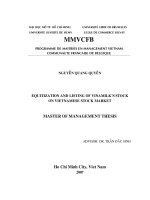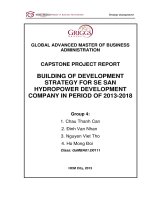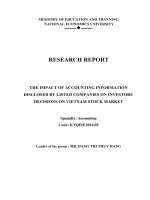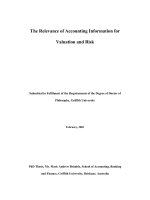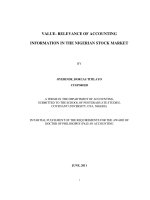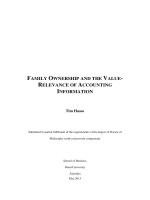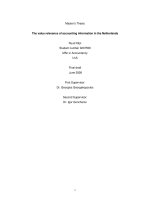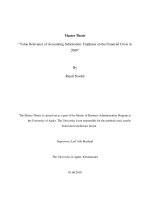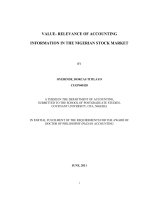value relevance of accounting information for investors by large listed company in vietnamese stock market
Bạn đang xem bản rút gọn của tài liệu. Xem và tải ngay bản đầy đủ của tài liệu tại đây (1.15 MB, 83 trang )
1
VALUE RELEVANCE OF ACCOUNTING INFORMATION FOR INVESTORS
BY LARGE LISTED COMPANY IN VIETNAMESE STOCK MARKET
BY
LAM THI BICH NGOC
E0600096
Graduation Project Submitted to the Department of Business Studies, HELP
University College, in Partial Fulfillment of the Requirements for the Degree of
Bachelor of Business (Accounting) Hons
JUNE 2010
2
DECLARATION
I hereby declare that this graduation project is based on my original work except for
quotations and citation which have been duly acknowledged. I also declare that it has not
been previously or concurrently submitted for any other courses/degrees at HELP
University College or other institutions. The word count is: 10125 words
Lam Thi Bich Ngoc
Date:
3
VALUE RELEVANCE OF ACCOUNTING INFORMATION FOR INVESTORS
BY LARGE LISTED COMPANY IN VIETNAMESE STOCK MARKET
BY
LAM THI BICH NGOC
June 2010
Supervisor: Dr. Dang Duc Son
Abstract
Value relevance of accounting information is not a new concept. There are many
researchers who have been trying to build up different aspect of value of accounting
information for investors by providing surveys and assumptions. These theories have
similar basic knowledge. But there are still a gap of investors usage of accounting
information between Vietnam and other countries. By taking applicable theories and
practicing from previous studies, the researcher does a research by dividing 100
questionnaires to investors in Hanoi Securities Trading Center (HASTC). The aim of the
research is to determine whether accounting information affects the investor‟s decision
and the frequency of the use of information by investors. The result of this research
show that Accounting information is an important reference source when investors make
investment decisions. This also shows that investors did not completely rely on
accounting information for their investment investors because they worried about
information disclosed.
4
TABLE OF CONTENTS
Page
Declaration of Originality and Word Count
ii
Abstract
iii
Table of Content
iv
List of Figures
viii
List of Abbreviations
ix
CHAPTER 1 INTRODUCTION
1
1.1 Research background
2
1.2 Problem Statement
3
1.3 Objective and Scope of Research
5
1.3.1 Objectives of Research
5
1.3.2 Scope of Research
5
1.4 Research Methods
5
1.5 Structure of Research
6
5
CHAPTER 2 LITERATURE REVIEW
7
2.1 Financial Statements – The Important Source of Accounting
Information for Investors in Vietnamese Stock Market
8
2.1.1 Balance Sheet
8
2.1.2 Income Statement
9
2.1.3 Cash flow Statement
9
2.1.4 Note to the Financial Statements
10
2.1.5 Disclosure of Information of Public Companies under
Vietnamese Accounting Standards
11
2.1.5.1 Periodical Disclosures of Information
11
2.1.5.2 Extraordinary Disclosures of Information
14
2.1.6 Financial Ratios
16
2.1.6.1 Liquidity Ratios
16
2.1.6.2 Profitability Ratios
18
2.1.6.3 Financial Leverage Ratios
21
2.1.6.4 Dividend Policy Ratios
22
2.1.6.5 Asset Turnover Ratios
22
6
2.2 Value-relevance Literature
24
2.3 Requirements of Investors about the Quality of Accounting Information
Disclosure
26
2.3.1 Truthfulness
27
2.3.2 Objectivity
27
2.3.3 Materiality
28
2.3.4 Relevance
28
2.3.5 Timelines
28
2.3.6 Understandability
29
2.3.7 Comparability
29
CHAPTER 3 RESEARCH METHODOLOGY
30
3.1 Research Objectives
31
3.2 Research Strategy
31
3.3 Data Source
31
3.3.1 Secondary data
31
3.3.2 Primary data
32
7
3.4 Research Methodology
32
3.5 Research Tool
33
3.6 Data Collection
34
3.7 Sampling
34
3.7.1 Sample Population
34
3.7.2 Sample Frame
35
3.7.3 Sample size
35
CHAPTER 4 RESULTS AND DISCUSSION
36
4.1 Introduction
37
4.2 Results and Discussion
35
4.2.1 Part A
35
4.2.2 Conclusion of Part A
40
4.2.3 Part B
42
4.2.4 Conclusion of Part B
44
4.2.5 Part C
45
4.2.6 Conclusion of Part C
50
4.3 Conclusion of the Survey
56
8
CHAPTER 5 CONCLUSION AND RECOMMEDATION
58
5.1 Conclusion
59
5.2 Recommendation
61
5.3 Limitation of Study
63
5.4 Suggestion for Future Research
64
REFERENCES & BIBLIOGRAPHY
65
APPENDICES
68
9
LIST OF FIGURES
Figure
Title
Page
Chapter 1
N/A
N/A
Chapter 2
N/A
N/A
Chapter 3
Figure 3.1
Data collection
34
Chapter 4
Figure 4.1
Age
38
Figure 4.2
Gender
38
Figure 4.3
Occupation
39
Figure 4.4
Annual Income
39
Figure 4.5
Time
42
Figure 4.6
Type of Market
43
Figure 4.7
Investment Form
43
Figure 4.8
Usage of accounting information
45
Figure 4.9
Interest Level
46
10
Figure 4.10
Effect of Accounting Information
46
Figure 4.11
Investment Channels
47
Figure 4.12
Financial Statements
47
Figure 4.13
Analysis Types
48
Figure 4.14
Financial Ratios
49
Figure 4.15
Satisfaction Levels
50
11
LIST OF ABBREVIATIONS
Abbreviations
Full Name
CAPM
Capital Asset Pricing Model
DCF
Discounted Cash Flow
FS
Financial Statement
HASTC
Hanoi Securities Trading Center
HSC
HoChiMinh Securities Corporation
SSC
State Securities Commission
SE
Security Exchange
VAS
Vietnamese Accounting Standard
WTO
World Trade Organization
12
CHAPTER 1: INTRODUCTION
1.1 Research Background
1.2 Problem Statement
1.3 Objectives and Scope of Research
1.4 Research Methods
1.5 Structure of Research
13
1.1 Research background
Vietnam has increasingly opened the economy and trade, remarkably after
joining the World Trade Organization (WTO) in 2007. As a result, it attracts
more investments from foreign companies and institutions. Vietnam‟s economy
becomes emerging market economy. On July 10
th
1998, two securities trading
centers at Hanoi (HASTC) and Ho Chi Minh City (HSC) were set up and marked
the formation of Vietnam‟s stock market. The first trading session took place on
July 28
th
2000 with two types of listing stocks. After ten years of operation, from
only a few companies listed, so far on both HASTC and HSC have nearly 500
listed companies. In 2000, share transaction reached only 1.37 billion VND per
session, 0.03 billion of bond transactions per session; to February 2010, share
transactions to 1520 billion VND per session and bond transactions to 216 billion
per session. From a capitalization of only 0.28% of GDP in 2000, to the end of
14
February, 2010 has reached 38.57% of GDP. Vietnam‟s stock market has an
important contribution to assist governments and enterprises to mobilize long-
term investment capital market development, business expansion, making the
economy less dependent on bank credit.( hsx.vn)
There are many types of economic decisions, so there are also many types of
accounting information. Financial accounting information is the major type that
investors need in the stock market. It illustrates the financial resources, financial
situation and activities of an organization ( or an individual). The role of
accountants is to summarize and analyze the financial accounting information of
the economic entity. Then, the users can have an overview about financial
resources at a time period and operations of that economic entity. The purpose of
financial accounting information is to support investors and creditors in deciding
where to put their scarce investment resources. (blogspot.com)
The goal of financial statements is to provide useful accounting information to
investors in making economic decisions. However, when the principles,
requirements and instructions for compiling and presenting the financial
statements are not clear and complete lack of uniformity, or difficult to apply,
will not guarantee the properties (reliability, understandability, comparability), so
that financial statements become less useful. Thus, accounting information from
those financial statements may cause bad impacts to the decisions of investors.
Useful accounting information is subject with special attention of many
15
professional organizations, researchers, practicing accountants on the world for
years with many different angles approach. (atc.edu.vn )
1.2 Problem statements
The purposes of accounting information are to provide information of a business
about its: assets, liabilities, equity, revenues, income, expenses, profits and
losses, cash flows. It assists users predict future cash flows, especially the timing
and the degree of certainty of making cash flow and cash equivalents.
Accounting information helps managers to consider the situation of enterprises:
whether good operation or not; which field brings success for enterprise; the
strengths and weaknesses of the financial situation of enterprises; which needs to
change to improve and increase business value. Financial accounting field
provides effective information to investors, so as to aid potential investors or
funds evaluate and making investment decisions.
Accounting information is seen as a kind of basic information provided to
investors on the stock market. Through the analysis of accounting information,
investors will find out: how business activities of enterprise are? How much
expected income is? Where competitive position is? It has capability of
improving the competitive position or not? And the final decision is about
whether invests in such enterprise or not?
16
Accounting field gives information for financial decision making. For example,
application of DCF model to analyze whether to invest in a government bond or
not; or CAPM model to examine and determine the cost of using capital in order
to decide whether to mobilize capital by issuing shares or not. (Peter Jennergren,
2008)
Accounting information is reliable when users can put their faith in it to make
decisions. Base on two important features: honest presentation and check ability.
In addition, the truthfulness of the information also has interaction relationship
with two above features to affect the usefulness of information.
1.3 Objectives and Scope of the Research
1.3.1 Objectives
Determine whether accounting information affects the investor‟s decision
The frequency of the use of information by investors
Suggest some solutions to improve accounting information which
investors use
1.3.2 Scope
Place of conducting research: Ha Noi stock exchange
Object of research: Investors
Period of conducting research: From 17
th
May 2010 to 7 June 2010
17
1.4 Research method
This project is based on the practical research and investigation.
The researcher operates the survey among investors in Ha Noi stock exchange.
The previous surveys and researches from different areas in Vietnam contain the
information which could help the researcher to design the questionnaire and
measurement. This research follows quantitative method with a sample of n =
100. By distributing questionnaire to investors, the researcher could collect and
analyze data and know the frequency of the use of accounting information in
Vietnam stock market.
1.5 Structure of the research
This project included five chapters:
Chapter 1: Introduction
Chapter 2: Literature Review
Chapter 3: Research Methodology
Chapter 4: Results and Discussion
Chapter 5: Conclusion and Recommendation.
18
CHAPTER 2: LITERATURE REVIEW
2.1 Financial Statements –The Important Source of Accounting Information for
Investors in Vietnamese Stock Market
2.2 Value – Relevance Literature
2.4 Requirements of Investors about the Quality of Accounting Information
Disclosure
19
2.1 Financial statements – the important source of accounting information for
investors in Vietnamese stock market
Financial statements, are always created in compliance with accounting
standards, must be studied and interpreted if they are to be used as a basis of
comparisons. Given the varied legal, economic and political backgrounds in
countries around the world, it is not surprising that the national accounting
standards vary among countries. Decision No. 15/2006 20
th
March 2006 of the
Minister of Finance of Vietnam prescribed financial reporting system of
enterprises including annual financial statements and interim financial
statements. The followings are the main financial statements under Vietnam
Accounting Standards.
20
2.1.1 The balance sheet
The balance sheet is one of the extremely important financial statements to
enterprise; reflect the general case of the entire value of existing assets and assets
that form part of the enterprise at a certain time. Through balance sheet, user
analyzes and evaluates the prospects and future prediction. Balance sheet also
provides information to users about enterprise liability for tax authorities,
employees, investors, bank and suppliers, etc.
2.1.2 Income statement
Income statement reflects the business situation and results of operations of the
enterprise including business results and other results. Investors are always
interested in income statement most in the investment decision.
Through the income statement data, investors have the financial information
(revenue, cost of good sold, interest, profit, etc) is used to calculate the financial
ratios as a basis for reflecting the financial situation of enterprise.
2.1.3 Cash flow statement
21
Cash flow statement is prepared in accordance with Vietnamese Accounting
Standards No. 24 (VAS 24).
Cash flow statement provides information related to three main activities to
generate and use money: operating activities; financial activities; investing
activities.
Cash flow reflects enterprise‟s situation. Enterprise‟s cash flow is what is real
and not affected by the principles of accounting. Using cash flow statements,
investors can assess the quality of income that business generated. It will help
investors eliminate doubts about the use of accounting methods to make profit.
2.1.4 Notes to the financial statement
Notes to the financial statements must present the full required criteria by
Accounting Standard No.21 – Presentation of financial statements and other
related standards.
Note to the financial statements is a synthesis report which is used to explain and
supplement information on the situation of production and business activities, the
financial situation of enterprises in the reporting period that the other financial
statements have not presented clearly and specifically. It provides data and
information to analyze and evaluate the situation of fixed assets increase or
decrease in each category, each group; increased or reduced each type of the
22
equity capital situation and logical analysis in the division complementary
structure, solvency of the enterprise, etc.
Note to the financial statements is an inseparable component of financial
statements with a nature of narrative or detailed analysis of the data presented in
the balance sheet, income statement, cash flow statement as well as other
necessary information as requested. Notes to the financial statements of
enterprise must present the following:
Information about the basis compilation and presentation of financial
statements and specific accounting policies which are selected and
applied to the important transactions and events;
Presenting information in accordance with the accounting standards has
not been disclosed in financial reports (critical information);
Providing additional information which is not presented in the financial
statements, but needed to present the financial situation of enterprises
honestly and reasonably.
Note to the financial statements gives very detailed information in the financial
statements in order to help investors understand their actual operation situation of
enterprises in the reporting period.
Note to the financial statements may also be stated more information on stock
ownership by employees, stock options…, these things are also important for
investors.
23
Other matters are given in the note to the financial statements including all errors
in the earlier accounting report involved laws that business related. Investor
could not miss this kind of information.
2.1.5 Disclosure of information of public companies under Vietnamese
Accounting Standards.
The following are two provisions of information disclosure of public companies
in accordance with Vietnamese Accounting Standards.
2.1.5.1 Periodical disclosures of information
No later than ten (10) days from the expiry of the period for completion
of annual financial statements, a public company must make a disclosure
of information about its annual financial statements audited by an
independent auditing firm which satisfies practicing conditions in
accordance with regulations of the Ministry of Finance.
The contents of information to be periodically disclosed about annual
financial statements shall be as follows:
The contents of information to be disclosed about annual financial
statements shall comprises the accounting balance sheet, income
statement, cash flow statement, note to the financial statements in
accordance with the law on accounting, and an audit report. The note
24
to the financial statement must state all the contents stipulated by the
law on accounting. If the explanation refers to an appendix, such
appendix must be disclosed together with the note of the financial
statements. The explanation must specifically state the contents of
transactions entered into with related parties in accordance with
Accounting Standard number 26 and the Circular providing
guidelines on Accounting Standards number 26, and must contain
departments‟ reports as stipulated in Accounting Standards number
28 and the Circular providing guidelines on Accounting number 28.
In case where the currency recorded in the accounting books is not
VND, the public company must make a simultaneous disclosure of its
financial statements in the currency recorded in the accounting books
and also in VND.
In the case where a public company is the parent company of another
institution, disclosure of annual FSs shall include the FSs of the
parent company as well as consolidated FSs in accordance with the
LOA.
The date of completion of annual FSs shall be no later than ninety
(90) days from the last day of accounting period in accordance with
the LOA.
A public company must prepare and disclose its annual report in
accordance with Appendix 2 and the disclosure must be made no later
than twenty (20) days from the expiry of the period for completion of
the annual FSs
25
The annual FSs and annual report of a public company must be in
Vietnamese (accompanied by English translations if applicable), must
be also disclosed in publication and on the electronic information site
of such company, and must be archived for at least ten (10) years at
the head office of the company in order to enable investors to refer to
such items.
A public company must disclose all the contents and information
about annual FSs as stipulated in Clause 1.1 if Section I of this
Circular on the information disclosure me dia of the SSC and SE (in
the case of a listing company) and concurrently publish the full text of
the audit report on the annual FSs in one (10) edition of a newspaper
published nationwide accompanied by the address of the electronic
information site which publishes all FSs or address where the FSs are
provided, in order to enable investors to refer to such items.
2.1.5.2 Extraordinary disclosures of information
A public company must make an extraordinary disclosure of information
in accordance with Clause 2 and 3 of article 101 of the law on securities,
and specifically as follow:
A public company must make an extraordinary disclosure of
information within twenty four (24) hours of the occurrence of
one of the following events:

